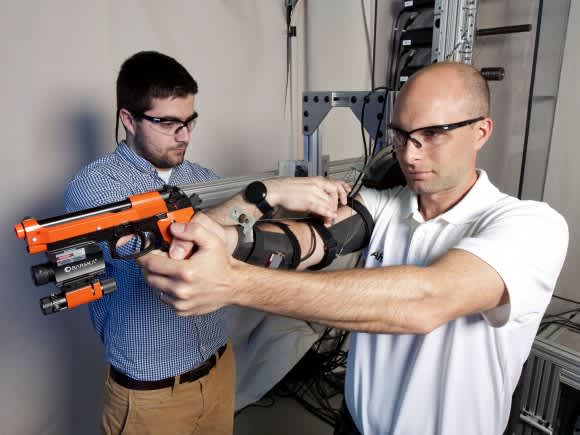US Army Develops Exoskeleton to Improve Handgun Accuracy
OutdoorHub Reporters 07.06.15

Forget gun attachments, the US Army is now considering add-ons for the human body.
Taking inspiration straight from science fiction, researchers at the US Army Research Laboratory in Maryland are developing new ways to improve handgun accuracy for soldiers. One method is the mechatronic arm exoskeleton (MAXFAS), a futuristic carbon-fiber arm brace that trains users to shoot more accurately and to reduce hand shake when presenting a handgun.
According to Dan Baechle, the mechanical engineer behind the project, he first got the idea from the iconic power loader in the film Aliens.
“Soldiers need to be able to aim and shoot accurately and quickly in the chaos of the battlefield,” Baechle said in a press release. “Training with MAXFAS could improve Soldiers’ accuracy, and reduce current time and ammunition requirements in basic training.”
The idea behind the arm brace is actually quite simple. Modeled after the same robotic limb used to train stroke victims how to reuse their arms, MAXFAS was designed to stabilize a shooters arm during the shooting cycle. According to researchers, volunteers who wore and trained with the arm brace retained steadier aim, even well after the brace was removed.
“The braces are made from carbon fiber, and add very little weight to the arm. Sensors on the braces feel the involuntary tremor in the arm and send signals to the motors to correct it, but do not restrict voluntary motion,” stated the release.
Training may be the first step, but Baechle intends for the exoskeleton to reach the battlefield as well.
“We strive to develop new approaches to challenging Army problems, and are especially attracted to high-risk projects that could drastically improve soldier capabilities,” said Eric Wetzel, leader of the Army Research Multifunctional Materials Team. “Dan’s work demonstrates that the integration of advanced materials, robotics, and control algorithms can help address a critical Army requirement—shooting proficiency—in an unconventional way.”

On a battlefield, the exoskeleton will also help soldiers deal with arm fatigue, involuntary tremors, and in difficult or stressful situations like firing on the move or shooting back while under enemy fire.
Baechle said that while the team is far away from catching up to Hollywood—and the armor seen in the new Iron Man movies—they are most certainly moving forward.
“In science, we are making great progress toward making science fiction a reality,” he said.

